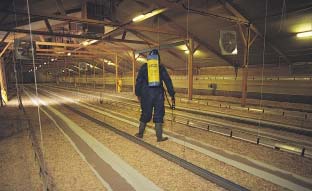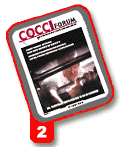Keeping it Simple
Like the U.S., Latin America and Asia, Europe is finding vaccination to be an effective "and convenient "method of managing coccidiosis in broilers

Applying Paracox-5 to feed in the
UK. A spray cabinet option will be
available in the near future.
|
The European broiler market
is discovering that vaccination
is not only an effective
way to manage coccidiosis, but that
it simplifies logistics at the feed mill
and processing plant.
"Extensive studies in the lab, on
floor pens and in the field show that in
standard broilers, just one dose of vaccine
given to day-old chicks controls
coccidiosis," says Dr. Luciano Gobbi,
Verona, Italy, a veterinary consultant
who has been involved with coccidiosis
vaccine testing.
Vaccination against coccidiosis, he
explains, prevents coccidial infection
by initiating the development of immunity.
In contrast, in-feed coccidiostats
prevent coccidial infection by suppressing
the parasite's life cycle, but resistance
to in-feed products has been a
worrisome and growing problem.
Vaccination Results
To illustrate the impressive results
obtained with vaccination, Gobbi
points to several carefully controlled
commercial trials conducted in Spain
with male and female broilers (Ross,
Cobb, Hybro-G). The birds received
either a coccidiosis vaccine or traditional
in-feed coccidiostats (nicarbazin +
monensin or nicarbazin + salinomycin)
and were assessed for as long as 51
days.
"There were either no significant differences
in live weight between birds in
both treatment groups, or the vaccinated
birds were significantly heavier
than the coccidiostat-medicated chickens,"
he says.
Similar observations come from Dr.
Michael Francis, director of biological
research and development, Schering-
Plough Animal Health, which manufactures
the Coccivac and Paracox brands
of coccidiosis vaccines.
In controlled field trials conducted
in France, the U.K. and Italy, there were
no reported coccidiosis outbreaks in
birds that received coccidiosis vaccination,
he says.
In addition, laboratory studies with
vaccinated birds exposed to coccidial
infection showed "significant protection"
determined several ways, including
oocyst output and lesion development,
Francis says.
Simplifies Management
In addition to effective coccidiosis control,
vaccination has other important
advantages, according to Gobbi. "It
greatly simplifies feed-mill management,"
he says.
Currently, feed mills manage several
in-feed coccidiostats and provide different
diets for broilers of different ages.
This is necessary because coccidiostats
must be rotated periodically to help
minimize the coccidiostat resistance
problem, he says.
"Considering that one feed mill may serve 200 to 300 farms, it can be difficult
to be sure each farm gets the correct
diet, with the correct coccidiostat,"
Gobbi says.
There is always a risk that the wrong
diet will be sent to a farm, or a diet
without an in-feed coccidiostat at all.
Such errors can result in a coccidiosis
outbreak in unvaccinated birds.
"The vaccine, however, eliminates
these potential problems by eliminating
the need for in-feed coccidiostats," he
adds. "Feed mills also will have fewer
regulatory worries since they will be
managing fewer in-feed drugs."
Processing Flexibility
Dr. Charlie Broussard, a veterinarian
with Schering-Plough Animal Health,
cites other advantages of vaccination.
"It eliminates concerns about toxicity,
residues and withdrawal times," he
says. "This is particularly helpful at a
time when there is increased consumer
demand for more natural food."
Vaccination also gives producers
more processing flexibility. Farmers
often process birds based on market
need. But if in-feed coccidiostats are
used and a withdrawal period is necessary,
they cannot always supply birds
when supermarkets need them.
"The vaccine will better enable producers
to process birds on short notice,
meeting the demands of clients and the
public," adds Broussard.
Growing Track Record
The coccidiosis vaccine now available
for broilers in Europe is Paracox™-5,
which is also marketed in Israel.
In the United States, Latin America
and Asia, a coccidiosis vaccine for
broilers called Coccivac-B is applied to
chicks at the hatchery with a spray cabinet.
"These vaccinse are producing
excellent results in studies and in the
field. Their use has increased tremendously
in light of growing coccidiostat
resistance and the increased public
demand for drug-free, natural birds,"
Broussard says.
Gobbi agrees and predicts that
coccidiosis vaccination will provide an
effective and easy way to manage coccidiosis
in broilers far into the future.
"It is clear that vaccination can provide
comparable or possibly better performance
than traditional in-feed coccidiostats,"
he says.
"In fact, immunological prophylaxis
with coccidiosis may provide broiler
producers with a way to keep coccidiosis
under real control for decades."
Boosting Vaccine Performance
Broiler producers can boost the effectiveness of coccidiosis vaccination by
practicing "good management," say Drs. Charlie Broussard and Luciano
Gobbi. |
Source: CocciForum Issue No.2, Schering-Plough Animal Health.







